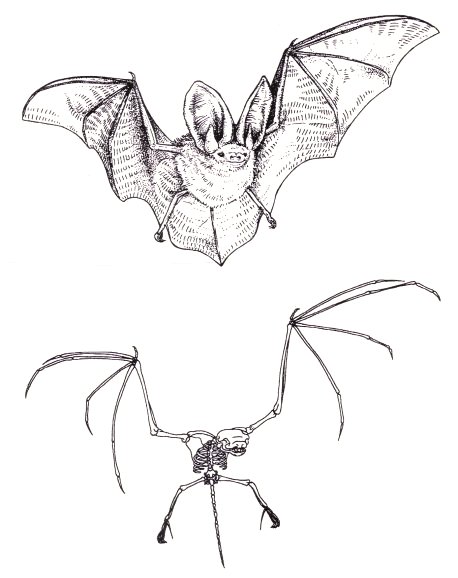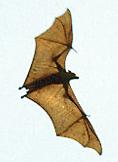Bat biology
Bats are the only mammal that can truly 'fly'. In fact their Latin name
Chiroptera is made up of two Greek words meaning hand (cheiros)
and wing (pteros). Other mammals such as some flying squirrels
may glide but they are unable to progress upwards and will finish up at
a lower height than where they started.
Bats were traditionally split into "small bats" and "big bats" -
Microchiroptera and Megachiroptera
but recent research suggests a more complex picture. Studies of genetics
show for example that the horseshoe bat family (that are insect eating
and tend to be small bats) are genetically more closely related to the
families of fruit bats we previously called megabats than they are those
families we called microbats. There are two alternative proposals for
how to group bats: Yinpterochiroptera / Yangochiroptera, and
Vespertilioniformes / Pteropodiformes; currently researchers do not all
agree which is correct and both sets of names are used.
In Britain all the native bats are nocturnal, echolocate and eat only
insects. Various reasons have been put forward for some bats remaining
nocturnal just like their mammalian ancestors:
- they avoid predation by day-flying birds
- they avoid the competition for food with day-flying
- they may be prone to overheating if they fly for long periods in strong
sunlight
Bats make up about a quarter of all the species of mammals on Earth with
more than 980 different species worldwide. Most species inhabit the tropical
and subtropical areas of the world but bats are found on all continents
except Antarctica where, to date, no bat fossils have ever been found.

Being mammals
they have fur and raise their young on milk from mammary glands. Mammals
(and birds) regulate their internal body temperature from within i.e.
they are endothermic. When it gets too cold they generate heat by the
oxidation of food (think of it as burning) to provide energy. When it
gets too hot most of them dissipate heat by the evaporation of their sweat
or saliva. The whole process, which is called homeostasis, is regulated
by a part of the brain in the hypothalamus.
 Bats
are very rare in the fossil record as their skeletons are small and light
and hence do not preserve well, especially in tropical conditions. The
first fossil remains that hint at being from bats are some mammal teeth
from the Paleocene era (65-55 million years ago). The next bat fossils
start turning up in the Eocene era (57-35 million years ago) and these
are complete skeletons that resemble modern-looking Microchiropterans.
The oldest known fossil from this period (Icaronycteris index)
has been X-rayed and shows specialisations of the auditory region of the
skull suggesting that it could echolocate. It was found in the Polecat
Bench rocks of Wyoming in the US. Similar specimens have been unearthed
in oil-shale pits at Messel near Darmstadt in Germany. The Messel fossils
show an amazing amount of detail due to the fine-grained rock and chemical
conditions of the site. Under the electron-microscope the pollen on the
wingscales of the moths that were the bats last meal can be seen. The
oldest Megachiroperan fossil was found in Italy and comes from the Oligocene
era (37-34 million years ago).
Bats
are very rare in the fossil record as their skeletons are small and light
and hence do not preserve well, especially in tropical conditions. The
first fossil remains that hint at being from bats are some mammal teeth
from the Paleocene era (65-55 million years ago). The next bat fossils
start turning up in the Eocene era (57-35 million years ago) and these
are complete skeletons that resemble modern-looking Microchiropterans.
The oldest known fossil from this period (Icaronycteris index)
has been X-rayed and shows specialisations of the auditory region of the
skull suggesting that it could echolocate. It was found in the Polecat
Bench rocks of Wyoming in the US. Similar specimens have been unearthed
in oil-shale pits at Messel near Darmstadt in Germany. The Messel fossils
show an amazing amount of detail due to the fine-grained rock and chemical
conditions of the site. Under the electron-microscope the pollen on the
wingscales of the moths that were the bats last meal can be seen. The
oldest Megachiroperan fossil was found in Italy and comes from the Oligocene
era (37-34 million years ago).
The smallest bat in the world is Kitti's Hog-nosed bat (Craseonycteris
thonglongyai) also known as the Bumblebee bat. It gets its name from
the shape of its nose, which appears to be mounted on a raised platform
and has slit-like, vertical nostrils. It comes from Thailand and Myanmar
(Burma), lives in limestone caves and eats insects, using echolocation
to find its way around and to catch food. It has a wingspan of 15cm and
weighs a tiny 1.5 to 2 grams. It was only discovered in 1974 and it
is on the list of endangered species.
 The
largest bat in the world is a large flying-fox bat with the Latin name
Pteropus vampyrus
but don't worry it's not a vampire - it eats
fruit, flowers, nectar, pollen and leaves! It has good eyesight, a huge
2m wingspan and weighs in at a whopping 1.2kg. It is found in S E Asia
and there are many subspecies. It is hunted for food by humans and in
Malaysia has been identified as a "reservoir" for the Nipah virus which
can cross from domestic pigs to humans. It is not popular with fruit farmers
and being on the menu as well as the destruction of its forest home has
meant that the species is now classed as threatened.
The
largest bat in the world is a large flying-fox bat with the Latin name
Pteropus vampyrus
but don't worry it's not a vampire - it eats
fruit, flowers, nectar, pollen and leaves! It has good eyesight, a huge
2m wingspan and weighs in at a whopping 1.2kg. It is found in S E Asia
and there are many subspecies. It is hunted for food by humans and in
Malaysia has been identified as a "reservoir" for the Nipah virus which
can cross from domestic pigs to humans. It is not popular with fruit farmers
and being on the menu as well as the destruction of its forest home has
meant that the species is now classed as threatened.
Vampire bats really do exist, but today there are only three species
and they live in Central and South America. As recently as a 20 to 30
thousand years ago they used to be much more widespread appearing in such
places as northern California.
There has been a remarkable arms race between bats and some prey, such
as moths and lacewings. Noctuid moths can sense the distance (judged by the volume) and direction
(by comparison of sound reaching two sound sensors on opposite sides of
its thorax) of an attacking bat. The moths can then retreat or in the
case of lacewings (Neuroptera)
escape by closing their wings and nose-diving. Some Noctuid moths have
'stealth' scales that appear to render them invisible to sonar. Some moths
may produce ultrasound to jam the bats' echolocation system. Others such
as Tiger (Arctiid)
moths
are unpalatable and produce ultrasound themselves, possibly
to warn bats to avoid them. When they hear a bat homing in on them these
moths produce clicks which are remarkably similar to those made by a bat
closing on its prey. The bats respond by veering away.